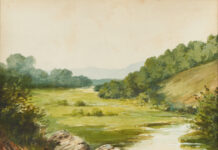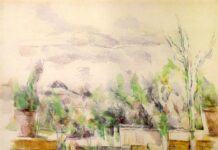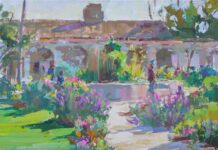“One of the most important aspects of my art practice is the mental preparation that I’m doing all the time,” says Thomas Bucci. “I’m always observing my surroundings and imagining how I might translate them into a language of pigment and paper, so that someone else might see what I see. Sometimes a scene serves up a ready painting idea and I just have to put it down on paper. More often ideas come from something less complete; a glimpse of atmospheric effects, the way sunlight lands on a surface, or an element in a landscape.

“This type of lobster co-op is one of a slowly disappearing breed of classic maritime fishing operations on Maine’s rugged coast. These timber-framed structures lean, bend, and bear the scars of time. With countless patches to repair over a century of wear, they still proudly stand up to the weather and function as originally intended, many decades ago.
“The mist in the still air of this scene is depicted by gradually lighter values going to the background. Control of the values is challenging as watercolor dries lighter than when first applied.
“An important aspect of this painting is the background graduated wash. Smooth and continuous graduated washes look very easy but can be quite tricky to execute. The paper has to be just the right dampness to allow the wash to flow, but not too fast or the paint runs down the page too quickly, spoiling the effect.”
ADVICE FOR ENTERING ART COMPETITIONS
Enter your favorite pieces and see what happens. You have to put yourself out there and take some chances to get recognition, otherwise you may toil in obscurity.
“Port Clyde, Co-op Cove” by Thomas Bucci won Third Place in the February Plein Air Salon art competition.







